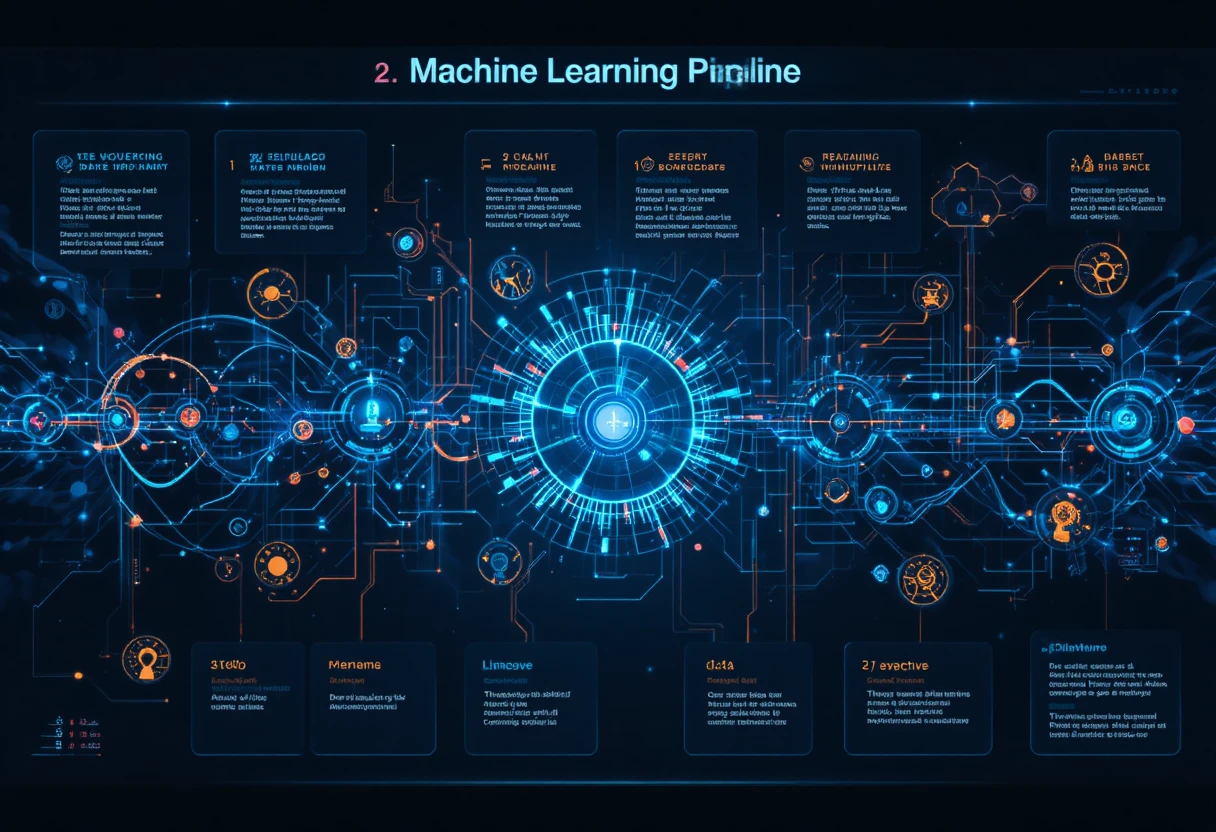Machine Learning (ML), a cornerstone of artificial intelligence (AI), has revolutionized how computers process data, make decisions, and adapt to new information. From personalized recommendations on streaming platforms to autonomous vehicles navigating complex environments, ML is reshaping industries and everyday life. This comprehensive 3000-word article delves into the fundamentals, types, applications, challenges, and future of machine learning, offering insights into its transformative potential.
What is Machine Learning?
Machine Learning is a subset of AI that enables systems to learn from data and improve performance without explicit programming. Instead of following hardcoded rules, ML algorithms identify patterns, make predictions, and refine their accuracy over time by processing vast amounts of data. At its core, ML mimics human learning by iteratively adapting to new information.
A Brief History of Machine Learning
The roots of ML trace back to the 1950s, when early AI researchers explored how machines could learn from experience. In 1959, Arthur Samuel defined machine learning as the “field of study that gives computers the ability to learn without being explicitly programmed.” Early efforts, like Samuel’s checkers-playing program, laid the groundwork for adaptive algorithms.
The 1980s and 1990s saw advancements in statistical methods and neural networks, but limited computing power and data availability constrained progress. The 21st century marked a turning point, with the rise of big data, cloud computing, and powerful GPUs (Graphics Processing Units). These advancements enabled complex ML models, such as deep learning, to flourish, propelling ML into mainstream applications.

Types of Machine Learning
Machine Learning is broadly categorized into three main types based on how algorithms learn from data: Supervised Learning, Unsupervised Learning, and Reinforcement Learning. Each approach has unique characteristics and applications.
Supervised Learning
Supervised learning involves training an algorithm on a labeled dataset, where each data point includes an input and a corresponding output. The algorithm learns to map inputs to outputs, enabling predictions on new, unseen data. For example, in spam email detection, a supervised model is trained on emails labeled as “spam” or “not spam” to classify future messages. Common algorithms include linear regression, logistic regression, and support vector machines.
Unsupervised Learning
Unsupervised learning works with unlabeled data, where the algorithm identifies patterns or structures without predefined outputs. Clustering and dimensionality reduction are common tasks. For instance, in customer segmentation, unsupervised algorithms group similar customers based on purchasing behavior. Popular techniques include k-means clustering and principal component analysis (PCA).
Reinforcement Learning
Reinforcement learning involves an agent learning through trial and error in an environment, guided by rewards or penalties. The agent optimizes its actions to maximize cumulative rewards. This approach is used in robotics, gaming (e.g., AlphaGo), and autonomous systems. Reinforcement learning is particularly powerful in dynamic, complex scenarios where explicit instructions are impractical.
Other Paradigms
Beyond these core types, hybrid approaches like semi-supervised learning (combining labeled and unlabeled data) and self-supervised learning (generating labels from data itself) are gaining traction. These methods address challenges like data scarcity and improve model efficiency.
How Machine Learning Works
Machine Learning relies on a combination of data, algorithms, and computational power. Understanding its building blocks provides insight into its functionality.
Data: The Fuel of ML
Data is the foundation of ML. High-quality, diverse datasets enable models to learn effectively. Data preprocessing—cleaning, normalizing, and transforming raw data—is critical to ensure accuracy. For example, in image recognition, datasets like ImageNet provide millions of labeled images to train models.
Algorithms: The Brains of ML
ML algorithms process data to identify patterns and make predictions. Common algorithms include decision trees, random forests, and neural networks. The choice of algorithm depends on the task, data type, and desired outcome. For instance, neural networks excel in image and speech recognition, while simpler algorithms like linear regression are suited for numerical predictions.
Training and Testing
ML models are trained on a subset of data, adjusting their parameters to minimize errors. The trained model is then tested on a separate dataset to evaluate performance. Metrics like accuracy, precision, recall, and F1-score assess model quality. Overfitting (when a model performs well on training data but poorly on new data) is a common challenge addressed through techniques like regularization and cross-validation.
Computational Power
Modern ML relies on powerful hardware, such as GPUs and TPUs (Tensor Processing Units), to handle large-scale computations. Cloud platforms like AWS, Google Cloud, and Azure provide scalable infrastructure, making ML accessible to businesses and researchers.

Applications of Machine Learning
Machine Learning’s versatility drives innovation across industries, transforming how businesses operate and individuals interact with technology.
Healthcare
In healthcare, ML improves diagnostics, treatment planning, and patient care. Algorithms analyze medical images to detect diseases like cancer or diabetic retinopathy with high accuracy. Predictive models forecast patient outcomes, while natural language processing (NLP) extracts insights from unstructured medical records. For example, Google Health’s ML model for breast cancer screening rivals human radiologists in accuracy.
Finance
ML enhances financial services through fraud detection, credit scoring, and algorithmic trading. Anomaly detection algorithms identify suspicious transactions in real-time, protecting against fraud. ML models assess creditworthiness by analyzing diverse data points, improving access to loans. In trading, ML predicts market trends, enabling high-frequency trading strategies.
Retail and E-Commerce
Retailers use ML for personalized recommendations, inventory management, and dynamic pricing. Recommendation systems, like those used by Amazon and Netflix, analyze user behavior to suggest products or content. ML optimizes supply chains by predicting demand, reducing waste, and improving delivery efficiency.
Transportation
ML powers autonomous vehicles by enabling real-time decision-making. Computer vision and sensor data help self-driving cars navigate roads, avoid obstacles, and follow traffic rules. Companies like Tesla and Waymo rely on ML to enhance safety and efficiency. ML also optimizes logistics, such as route planning for delivery fleets.
Marketing and Advertising
ML drives targeted advertising by analyzing user preferences and behavior. Ad platforms like Google Ads use ML to deliver personalized ads, maximizing click-through rates. Sentiment analysis, powered by NLP, gauges consumer opinions from social media, informing marketing strategies.
Manufacturing
In manufacturing, ML improves predictive maintenance, quality control, and process optimization. Sensors collect data from machinery, and ML models predict failures before they occur, minimizing downtime. Computer vision inspects products for defects, ensuring high standards.
Entertainment and Gaming
ML enhances entertainment through content personalization and game development. Streaming platforms use ML to recommend movies and music, while game developers employ reinforcement learning to create adaptive, intelligent non-player characters (NPCs). AI-generated art and music are also emerging, pushing creative boundaries.
Deep Learning: A Game-Changer in ML
Deep Learning, a subset of ML, uses neural networks with multiple layers to process complex data. Inspired by the human brain, deep learning excels in tasks like image recognition, speech processing, and NLP. Its success stems from large datasets, powerful hardware, and advanced architectures like convolutional neural networks (CNNs) and recurrent neural networks (RNNs).
Key Deep Learning Applications
- Image Recognition: CNNs power facial recognition, autonomous driving, and medical imaging.
- Speech Recognition: RNNs enable voice assistants like Siri and Alexa to understand spoken commands.
- Natural Language Processing: Transformers, like those in GPT models, generate human-like text and power chatbots.
Deep learning’s ability to handle unstructured data (e.g., images, audio) has driven breakthroughs, but it requires significant computational resources and labeled data, posing challenges for smaller organizations.
Challenges in Machine Learning
Despite its potential, ML faces several hurdles that must be addressed to ensure widespread adoption and ethical use.
Data Quality and Availability
ML models depend on high-quality, diverse data. Incomplete, biased, or noisy data can lead to inaccurate predictions. For example, biased datasets in facial recognition have caused misidentifications, raising ethical concerns. Access to large, labeled datasets is also a barrier for smaller entities.
Computational Costs
Training complex ML models, especially deep learning, requires substantial computational resources. High-end GPUs and cloud infrastructure are costly, limiting access for startups and researchers. Efforts to develop efficient algorithms, like federated learning, aim to address this.
Interpretability
Many ML models, particularly deep neural networks, are “black boxes,” making it difficult to understand their decision-making processes. This lack of transparency hinders trust in critical applications like healthcare and finance. Techniques like Explainable AI (XAI) are emerging to improve interpretability.
Bias and Fairness
ML models can perpetuate biases present in training data, leading to unfair outcomes. For instance, biased hiring algorithms may favor certain demographics. Addressing bias requires diverse datasets, regular audits, and fairness-aware algorithms.
Scalability
Deploying ML models at scale poses challenges, including real-time processing and integration with existing systems. Edge computing, where ML runs on devices like smartphones, is addressing scalability by reducing reliance on cloud infrastructure.

Ethical Considerations
The rise of ML raises ethical questions that demand careful consideration.
Privacy
ML models often process sensitive data, such as medical records or financial transactions. Ensuring data privacy through encryption, anonymization, and secure storage is critical. Regulations like GDPR and CCPA set standards for data protection.
Accountability
When ML models make errors, determining responsibility is complex. For example, if an autonomous vehicle causes an accident, who is liable—the developer, manufacturer, or user? Clear accountability frameworks are needed.
Job Displacement
ML-driven automation threatens jobs in sectors like manufacturing and customer service. While ML creates new roles, reskilling programs are essential to support workers transitioning to AI-augmented jobs.
Ethical AI Development
Developers must prioritize fairness, transparency, and inclusivity in ML systems. Ethical guidelines, such as those from IEEE, emphasize human-centric AI design to prevent harm and promote societal benefits.
The Future of Machine Learning
The future of ML is bright, with emerging trends poised to shape its evolution.
Automated Machine Learning (AutoML)
AutoML aims to democratize ML by automating tasks like model selection and hyperparameter tuning. Platforms like Google’s AutoML enable non-experts to build ML models, expanding access to AI technologies.
Federated Learning
Federated learning allows ML models to train on decentralized data, preserving privacy. For example, Google uses federated learning to improve keyboard predictions on smartphones without uploading user data to the cloud.
Quantum Machine Learning
Quantum computing promises to accelerate ML by solving complex problems faster than classical computers. While still in its infancy, quantum ML could revolutionize fields like cryptography and drug discovery.
Multimodal AI
Multimodal AI integrates multiple data types (e.g., text, images, audio) to create more robust models. For instance, models like CLIP combine vision and language for tasks like image captioning.
AI for Social Good
ML is increasingly applied to global challenges, such as climate change, healthcare access, and disaster response. For example, ML models predict wildfires, optimize renewable energy, and improve disease outbreak detection.
Conclusion
Machine Learning is the driving force behind AI’s transformative impact, powering innovations across healthcare, finance, transportation, and beyond. Its ability to learn from data and adapt to new challenges makes it a cornerstone of modern technology. However, addressing challenges like bias, interpretability, and ethical concerns is crucial to ensure ML benefits society equitably. As advancements like AutoML, federated learning, and quantum ML emerge, the future of machine learning promises to be even more dynamic, reshaping our world in profound ways.
